Thursday 28 April 2016
White: K. Nevols (132) - Black: K. Hyde (170)
Any real chances I had to catching up the top two were now gone - but with four games left I needed to consolidate third place. This game was a rematch with the club champion and highest graded player. In a sense, I felt more relaxed as I assumed it would be a defeat (!) and so I had nothing to lose.
1. e4 c5
Time for another Closed Sicilian, but this time I decided to delay the development of the king's bishop.
2. Nc3 Nc6
3. f4 g6
4. Nf3 Bg7
5. Be2
I decided to try the bishop on this square, behind the d3 pawn, for a change. Unambitious perhaps but adds to the defence and avoids the possibility of Black gaining tempi on the queenside by attacking it.
Playing 5. g3 with Bg2 is another possibility to be tried one day.
5. ... d6
6. O-O e6
7. d3 Nge7
Black decides to deploy his knight so as to not disrupt the bishop's diagonal and keeps firm control of the d4 square.
8. Qe1 O-O
9. Qh4
This is a standard manoeuvre of the system that I play. Pieces are moved generally in the direction of Black's king. Learning from my last game, however, I was intent on avoiding a pointless sacrifice on the f5 square.
9. .... Nd4
10. Bd1 d5!
The standard counterplay. I read somewhere that if Black can play d5 in a Sicilian defence then he is doing well. I decide to create a small weakness and redeploy the knight out of range of his d4 counterpart.
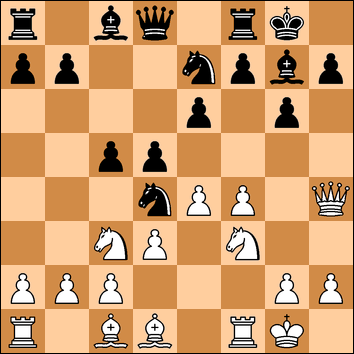
11. Ng5 h6
12. Nh3 Nec6
The move that had concerned me was 12. .. b5 grabbing the initiative with ideas such as b4 and maybe later Bb7. Now I decide to try to blunt Black's play with exchanges.
13. Qxd8 Rxd8
14. Ne2
Now Black, clearly ahead, has the possibility of 14. .. b6 with one line being 15. c3 Nxe2+ 16. Bxe2 Ba6 with pressure in the centre.
14. ... dxe4
15. dxe4 e5!
Breaking in the centre and opening up the diagonal of the queen's bishop. I was now getting concerned with the familiar feeling of slowly being outplayed.
16. c3
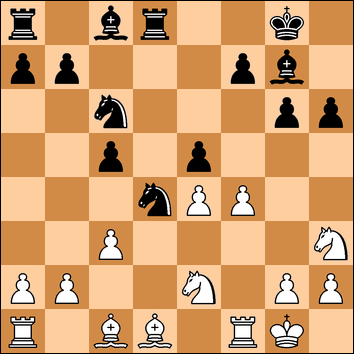
16. .... Nf3+
I did not see this until just after I played c3. This move exploits the overwork of the rook on f1. While Black thought about the move, I could not see any immediate danger.
17. gxf3 Bxh3
18. Re1
Now Black has a pleasant choice of plans. He could try 18. .. Bf6 with the idea of coming to h4. He could try Rd3. Or, as here, redeploy the bishop.
18. ... Be6
Although I am slightly worse, it is not yet in the disaster phase, and I felt slightly better than a few moves ago. Time for the bishops to do some work.
19. Be3 b6
One alternative idea is 19. .. Rd3 20. Bxc5 b6 21. Bf2 Rxf3
20. Ba4 Rac8!?
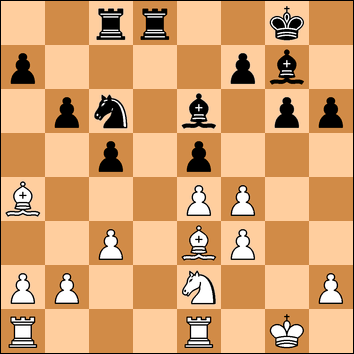
This is an interesting pawn sacrifice which I now spent some time looking at. 21. Bxc6 Rxc6 22. fxe5 Bxe5 23. Bxh6. I decided against it, as it seemed wrong by instinct to bring both his bishops to the centre and open the h-file for a Black rook to beam down towards the h2 square.
Black told me afterwards that he was thinking of ideas revolving around playing g5 - which I had not considered. One line could be 23. ... Bc4 24. Kg2 g5!? 25. Bxg5 Rg6 with f6 coming up. I think 24. Kh1 puts an end to those ideas - had I seen the g5 possibility.
Instead I just decide to play safe and improve the king's position.
21. Kg2 Kh7
Defending the pawn - the computer thinks 21. .. Rd3 is a useful try exploiting the fact that White still lacks some co-ordination.
22. Bb5
To defend the c4 square.
22. ... Na5
23. fxe5 Bxe5
24. Nf4 Bc4
But Black plays it anyway. I did not like 25. Bxc4 Nxc4 26. Rb1 with Black strong down the d-file so decide to move the bishop back to a better square. I had to find some counterplay against Black's dominance of the d-file and mobile queenside pawns.
25. Ba4 b5
26. Bc2 b4
27. Ne2 Bxe2
28. Rxe2 bxc3
29. bxc3
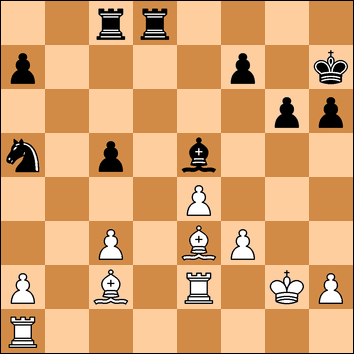
The recommended move is now 29. .. Nc4! with the threat of Nxe3 and Rd2+. So 30. Bc1 Rb8 and White is really struggling to move.
29. ... Bxc3
Now a pawn down - my hope is to get some active play by use of the rooks and bishops. First, I grab an open file.
30. Rb1 Bd4
Again 30. ... Nc4 is better.
31. Bf4!
I was pleased with this. By hitting the b8 square, my rook can't be challenged and I have chances now to exploit down the b-file.
31. ... Nc6?
The best move is, not easy to see, 31. ... Kg7 then if 32. Rb5 Nc4 remains a good square for the knight. There is the upcoming possibility of g5 which forces the white bishop back to the c1 square (if Bg3 then Nh3+). There is also the prospect of bringing the knight back to the d6 square where it defends the f7 pawn and the b7 invasion square.
On c6 the knight goes off astray. Now I can invade the seventh rank and win the pawn back.
32. Rb7 Kg7
33. Bb3 c4
The computer claims 33. .. g5 34. Bg3 Ne5 is a better defence with 35. Bxe5 Bxe5 36. Rxf7+ Kg6 37. Rxa7 c4 38. Ba4 Ra8. Black is a pawn down but the c-pawn is very well advanced.
34. Bxc4 Ne7
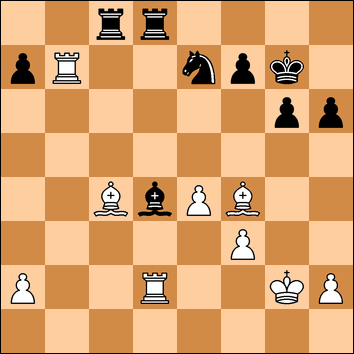
At the time I was impressed at this ingenious defence. But now I completely miss 35. Bc7! - an equally ingenious move. The rook has to move off the d-file (34. ... Rd7 35. Be5+) and then White could follow with Rc2 (defending the white squared bishop) and threaten Bd6 - and Black's seventh rank looks woeful.
35. Bb3 Bc5
36. Be3
And again missing a strong attack. 36. Rc2! (threatening Rxc5) Ba3 37. Bc7! Rf8 38. Rxa7 Ra8 39. Rb7 and White has all sorts of possibilities with attacks Rd2-d7 or Be5 and Rcc7.
Discovering this strong attack after the game against such a strong player was quite upsetting. My mood at the time was optimistic as, having regained the pawn, I thought I had good chances for the draw. I never thought I could win.
36. .... Bxe3
37. Rxe3 Rd2+
Black now finds counterplay which concerned me greatly.
38. Kh3 Kf8
39. Rxa7 Rc1
40. Kg3 Rg1+
41. Kh3
If 41. Kf4?? then Black takes the game with g5+ 42. Ke5 Nc6.
41. ... Rh1
42. f4 Rdxh2+
43. Kg4 Rh4+
44. Kf3 R1h2
And Black offered a draw (?) which was accepted. This was a relief as I think Black could be better in this position. The best line from here is 45. e5 Nf5 46. Re1 Nd4+ 47. Ke4 Nxb3 48. axb3 Rf2 and the question is whether White can drum up enough play to counter Black's play.
No comments:
Post a Comment